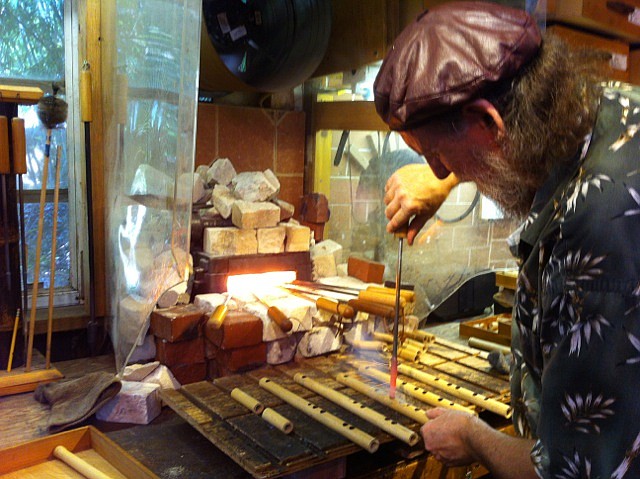- January 17, 2025
-
-
Loading

Loading

GOTHA — Dr. Henry Nehrling, the “patron saint of Florida gardens,” perhaps never imagined that some of the bamboo he planted long ago would one day produce beautiful music.
But Erik Sampson, aka “Erik the Flutemaker,” is busy doing just that, while also paying homage to Nehrling and other pioneering horticulturists. And soon, he plans to release a new CD of bamboo-instrument music to honor Nehrling and benefit the nonprofit Nehrling Gardens.
The South Florida musician visited the gardens, 2267 Hempel Ave., Gotha, in August. Sampson fell in love with its stands of bamboo, including those that Nehrling planted more than 100 years ago next to Lake Nally.
“I’ve enjoyed finding these old gardens and historic bamboo clumps from satellite images,” Sampson, 62, said from his home in Davie.
With the blessing of Nehrling Gardens President Angela Withers, Sampson took home sections of the lakeside bamboo called Bambusa Multiplex. It is commonly known as “Silverstripe” bamboo and originates from southern China.
He first learned about Nehrling Gardens, its famous namesake and other historic bamboo sites while delving into historical records at Rollins College in Winter Park.
“I wanted to start visiting these places, cut the bamboo and make the flutes so people can hear the music,” Sampson said. “One of the deepest things in my heart is to give back to this fellowship of early horticulturists who brought bamboo into the United States.”
MAKING A CONNECTION
His inaugural trip to Nehrling Gardens was on a garden workday, during which volunteers remove invasive plants and perform other cleanups. Sampson quickly pitched in, as well.
“Coming through the door was such an honor,” he said. “It was a wonderful joy to connect with them.”
Withers said she was thrilled to meet Sampson, and she praised his musical talents.
“Although (his music) is varied — some of its jazzy, some is oriental and some Renaissance — it has a beautiful sense of tranquility about it,” she said.
Sampson said he has made 33 instruments and 11 bird flutes from the bamboo he collected in Gotha. The instruments include bamboo saxophones and flutes.
“About 98% of the bamboo of what I took at Nehrling was already dead and dry, so it’s less work to make the flutes,” Sampson said.
He plans to donate some of the new instruments to Nehrling Gardens, where they will be sold to raise money for improving and maintaining the property. Each one will be signed by Sampson and include the date and location where it was found.
Sampson also has been busy making music on some of the instruments for a new CD. Withers recently sent pictures of Dr. Nehrling to Sampson for the design of the disc, copies of which will be sold exclusively at Nehrling Gardens to raise money for the site.
“On Labor Day, I created nine pieces for the CD, and I’m working on some more,” Sampson said. “(Nehrling) loved birds, so it will have bird sounds, and rain and thunder. Some pieces are pretty exotic.”
During his visit, Sampson gave Nehrling Gardens’ officials some copies of his 2002 compilation CD, “Perfectly Mellow.” These discs feature 19 songs, including “Amazing Grace.” They sell for $10 apiece and benefit the gardens.
In addition, Sampson hopes to perform his music at the gardens’ annual holiday event Dec. 13.
PERFECT PITCH
Sampson has made bamboo flutes for 44 years. And overall, he has handmade more than 150,000 wind instruments. In his yard grow various stands of bamboo, much of which he uses to make his instruments.
“I have an acre of bamboo (at home), but I felt honored to use the bamboo from Nehrling Gardens,” Sampson said.
The process of making a bamboo flute can be quite extensive. For example, it sometimes takes a year to cure the bamboo, Sampson said. The overall process also involves washing, scrubbing and oiling the bamboo, drilling holes in it and using an electronic tuner to tune it.
During his career, Sampson has made flutes in various countries, including many in Central and South America. He said one of his biggest joys was the time he played a bamboo flute for the president of Fiji.
“(Flute making) not only provides me with a wonderful career, but also with a great retirement,” Sampson said. “That’s why I’m so grateful to these (bamboo pioneers like Nehrling).”
He also has a huge heart for the less fortunate. In 2006, Sampson started his nonprofit Flutemaker Ministries after he performed for 18 kids rescued from a garbage dump in Nicaragua.
Through the help of many customers, family and friends, Sampson and Flutemaker Ministries were able to buy land, build the kids a home, start a farm, sow into micro businesses and support efforts to feed children throughout Nicaragua, according to his website, eriktheflutemaker.com.
ABOUT THE GARDENS
Nehrling Gardens is owned and operated by a local, all-volunteer non-profit that is rehabilitating Dr. Henry Nehrling’s historic home and gardens, creating new teaching gardens and providing a historical, horticultural and environmental enrichment center for the community.
Henry Nehrling was an internationally renowned horticulturalist, naturalist, botanist, ornithologist and writer. He introduced and tested more than 3,000 new and rare species of plants and trees, as well as Florida native plants. More than 300 of these became essential to Florida’s horticulture industry, including caladiums, palms, bamboos, magnolias and amaryllis.
The Gardens became a mecca for plant lovers and a tourist destination in the early 1900s. It was visited by prominent people, such as Theodore Roosevelt and Thomas Edison, and renowned horticulturists like David Fairchild and Liberty Hyde Baily. Nehrling’s most notable works include “Our Native Birds of Song and Beauty” and “The Plant World in Florida.” Nehrling Gardens is on the National Register of Historic Places